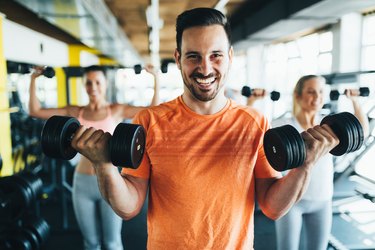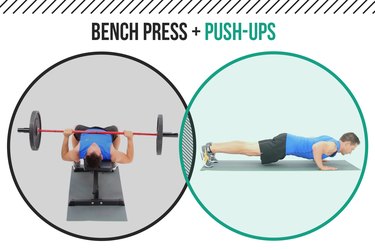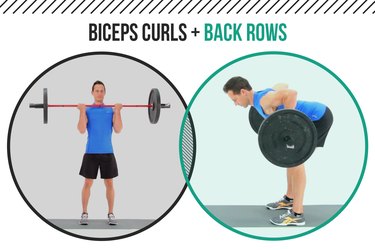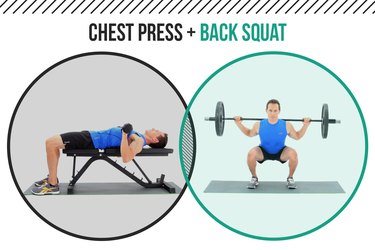
Your time is valuable. And your time in the gym, even moreso. That's why, if you want the most efficient way to structure your workouts, you should add supersets — pairs of exercises performed back-to-back with no rest in between.
"In general, paired exercises that work best either allow for a balanced muscle group (push then pull) or involve working one body part while the other rests, such as in alternating upper- and lower-body exercises," says Jason Machowsky, CSCS, a board-certified sports dietitian and performance specialist at the Hospital for Special Surgery in New York.
Video of the Day
Video of the Day
The following supersets will help you reach your fitness goals faster. Add these to parts of your current workouts or do three sets of each (resting one minute in between sets) for the ultimate full-body workout.
1. Bench Presses + Push-Ups

Performing bench presses followed by push-ups works similar muscle groups, making it more demanding on your pectorals (chest muscles). Called a "compound superset," the stress on each muscle is doubled as each exercise recruits the same muscles.
"This technique is best for more advanced exercisers," Machowsky says. And since using the same muscles will fatigue them more quickly, you'll need to use less weight and fewer reps.
Move 1: Bench Presses
- Lie on a flat bench with a barbell racked above you about eye level. Grip the barbell slightly wider than shoulder-width.
- Press your feet into the ground and lift the barbell off the rack and over your chest, keeping your hips against the bench.
- Bending at the elbows, lower the barbell to chest height, letting the elbows dip slightly below the bench.
- Press your feet into the ground and push the barbell back up, arms fully extended.
Move 2: Push-Ups
- Begin in a high plank, hands directly beneath your shoulders, body in a straight line from head to hips to toes. Avoid hiking or sinking your hips.
- Bending at the elbows, begin to lower your chest toward the ground, keeping a flat back. Your elbows should form a 45-degree angle with your ribs.
- When your chest hovers an inch off the ground (or as far as you can go), exhale and press into the floor to return to high plank.
Read more: 24 Push-Up Variations for a Stronger Body
2. Biceps Curls + Back Rows

The good thing about this superset is that if you pre-exhaust your biceps first, you'll be less likely to use them on back rows, says Michele Olson, PhD, professor of exercise science at Auburn University in Montgomery, Alabama. For rows, you should be focusing on squeezing your shoulder blades together instead of pulling your elbows back and bending your arms using your biceps, Olson says.
Move 1: Biceps Curls
- Stand holding a dumbbell in each hand.
- Keeping your elbows glued to your sides and your chest upright, raise the barbell up toward your shoulders.
- Slowly lower the barbell until your elbows extend fully at the bottom without locking.
Move 2: Back Rows
- Stand just behind a barbell, feet hip-width apart, and grab the bar in an overhand (palms down) grip.
- Press your feet down into the floor (or platform) to lift the bar up; think of keeping your back flat as you press your hips forward and pull your knees back.
- Hinge forward from the hips, softening your knees as necessary so that you can keep your back flat as you lean forward.
- Pull the bar up toward your waist. Squeeze your core to keep your torso stable as you do this.
- Maintain that stable core position as you extend your arms, lowering the bar to around ankle level.
3. Lunges + Single-Leg Deadlift

The combination of lunges and single-leg balancing exercises (like a single-leg deadlift) works similarly to the biceps curls and back rows, Olson says. "You pre-exhaust your hip and gluteal muscles on one side and then balance on the worked leg (right leg leading lunge, then balance on it doing single-leg deadlifts)."
The pre-exhausted muscles will have to work extra hard isometrically to keep you balanced. It's a great way to finish off your leg day workout, she says. Do lunges on the right leg first: three sets followed by 30 seconds of single-leg deadlifts. Repeat the sequence on the left leg.
Move 1: Lunges
- Stand with your feet about hip-width apart, arms at your sides.
- Step about 3 feet forward with your right leg, bending the knee until it forms a 90-degree angle. Keep most of your weight in your front leg.
- At the same time, bend your left leg to 90 degrees until your knee hovers an inch or two off the ground.
- Press into the heel of your right leg and use your glutes and hamstrings to press back to standing, bringing your right leg back to the starting position.
Move 2: Single-Leg Deadlift
- Stand on your right leg while holding a dumbbell at your side in your right hand.
- Keeping the right knee slightly bent, perform the deadlift by bending at the hip, extending your free leg behind you for balance or resting the top of your foot on a bench. During this movement, make sure your hips remain square.
- Continue lowering the dumbbell until your upper body is parallel to the ground.
- Keeping your back flat, return to the upright position.
- Repeat on the opposite side.
Read more: 22 New Lunges to Supercharge Leg Day
4. Barbell Biceps Curls + Triceps Extension

Working biceps and then triceps represents a traditional type of superset. Instead of performing back-to-back exercises working similar muscle groups, this uses an alternating "push and pull" technique, also known as the agonist and antagonist muscle groups. By alternating the active muscle groups, you ensure that the same muscle group will not be used for two consecutive exercises and overfatigue them.
Move 1: Barbell Biceps Curls
- Hold the barbell with both hands facing up at about shoulder-width distance.
- Keeping your elbows glued to your sides and your chest upright, raise the barbell up toward your shoulders.
- Slowly lower the barbell until your elbows extend fully at the bottom without locking.
Move 2: Triceps Extension
- Hold a barbell (or two dumbbells) above your head.
- Slowly and with control, lower the weight behind your head.
- Using your triceps, lift the weight back up over your head.
5. Chest Flyes + Supported Dumbbell Row

Another example of an opposing superset, chest flyes require a push and supported dumbbell rows consist of pulling, thereby working the opposite muscle groups: chest and back.
Move 1: Chest Flyes
- Lie back on an exercise bench or stability ball with a dumbbell in each hand.
- Press both dumbbells directly over your chest, bending your elbows slightly.
- Keeping the bend in your elbows, lower your arms out to the side of your chest.
- Press them back up to above your chest.
Move 2: Supported Dumbbell Row
- Adjust an exercise bench to a low incline — about 45 degrees.
- Holding two dumbbells, position yourself on the bench facing the back, placing your chest against the bench. Keep your legs extended on the sides of the bench to support your body. Let your arms hang extended.
- On an exhale, row the dumbbells to chest height, pulling your shoulder blades back.
- Extend the arms again, letting the dumbbells hang.
6. Dumbbell Chest Presses + Back Squats

Allowing one area of the body to rest while another works — most commonly alternating upper- and lower-body exercises — builds efficiency into the workout, since it reduces the amount of rest time you need, Machowsky says. These combinations also work well as part of a circuit workout.
Move 1: Dumbbell Chest Presses
- Lie on a flat bench, facing up and holding a dumbbell in each hand at chest level.
- Press your heels into the ground to raise the dumbbells over your chest back up.
Move 2: Back Squats
- Holding a barbell across your back, stand with your hips slightly wider than hip-width apart, toes pointing slightly outward.
- Push your hips back and, keeping your back flat and chest out, bend your knees.
- Lower down toward the ground until your thighs are parallel to the ground.
- Pause for a moment, then press into your heels. Push your hips forward and return to standing.
7. Barbell Shoulder Presses + Lateral Shoulder Raises

Both shoulder presses and lateral raises work the deltoid (shoulder) muscles, making this a compound superset.
Move 1: Barbell Shoulder Presses
- Hold a barbell with both hands at shoulder height.
- Press the weights up over your head until your arms are fully extended.
- Slowly lower the weight for 3 to 4 seconds until it reaches shoulder height again, elbows dipping below shoulder height.
Move 2: Lateral Shoulder Raises
- Stand with your back straight, feet flat on the ground, a dumbbell in each hand held at your sides.
- On an exhale, raise the two dumbbells up, forming a T shape with your upper body.
- Lower the weights back to your sides, keeping the weight controlled.
8. Back Squats + Deadlifts

These lower-body exercises done together are a push-and-pull set and represent a heavy-duty lower-body superset. Back squats are the "push," and the deadlift is the "pull."
Move 1: Back Squats
- Holding a barbell across your back, stand with your hips slightly wider than hip-width apart, toes pointing slightly outward.
- Push your hips back and, keeping your back flat and chest out, bend your knees.
- Lower down toward the ground until your thighs are parallel to the ground.
- Pause for a moment, then press into your heels. Push your hips forward and return to standing.
Move 2: Deadlifts
- Stand with your feet outside your shoulders. Point your toes out slightly.
- Stick your hips back and bend forward to grab the barbell below with both hands, using an overhand grip.
- Sink your hips down, flatten your back and pull the bar off the ground until you're standing straight up.
- Lower it back down to the ground under control with your back flat.
Read more: 6 Deadlift Variations to Add to Leg Day
9. Squats + Donkey Kicks

Squats combined with donkey kicks mimics a less advanced version of the squat-deadlift combo. Squats primarily strengthen and work the glutes and quadriceps, while donkey kicks focus on the hamstring muscles.
Move 1: Squats
- Stand with your hips slightly wider than hip-width apart, toes pointing slightly outward.
- Push your hips back and, keeping your back flat and chest out, bend your knees.
- Lower down toward the ground until your thighs are parallel to the ground.
- Pause for a moment, then press into your heels. Push your hips forward and return to standing.
Move 2: Donkey Kicks
- Start on all fours with your wrists below your shoulders and your knees below your hips.
- Keeping your hips square to the ground and your knees bent at a 90-degree angle, lift your right foot toward the sky as though you are stamping the bottom of your shoe on the ceiling. Squeeze through your glutes to lift.
- Lower that leg back down and repeat.